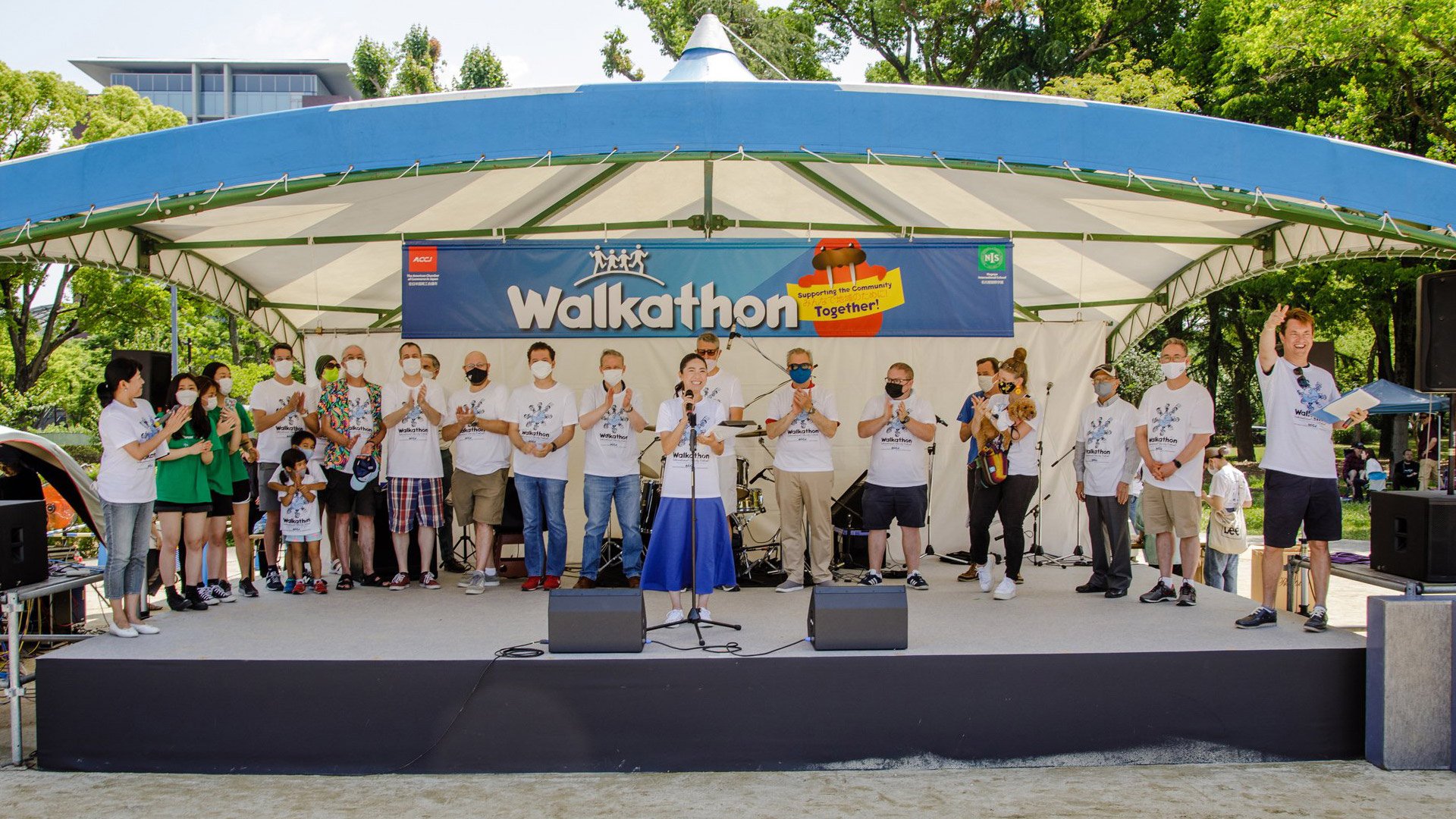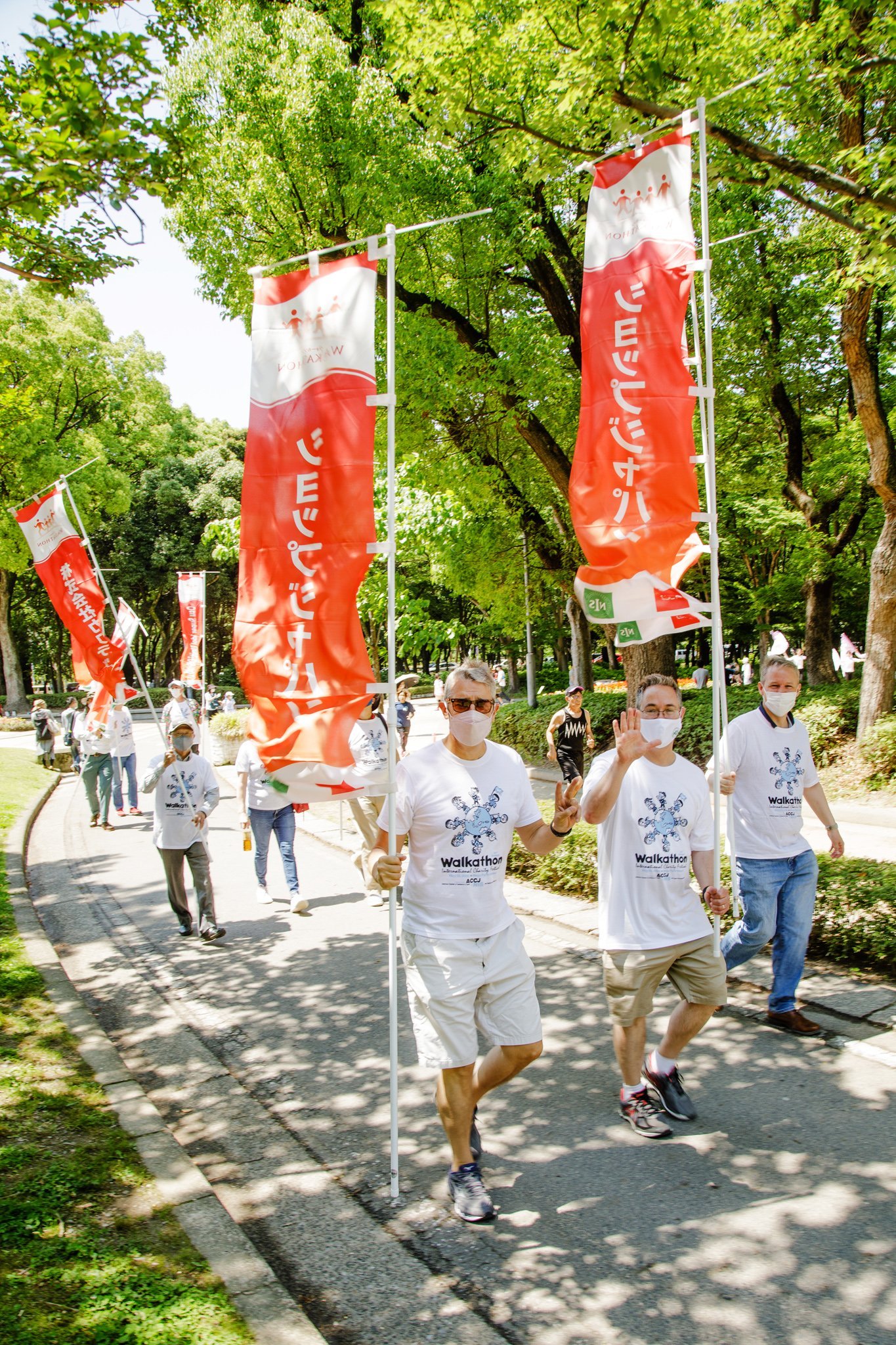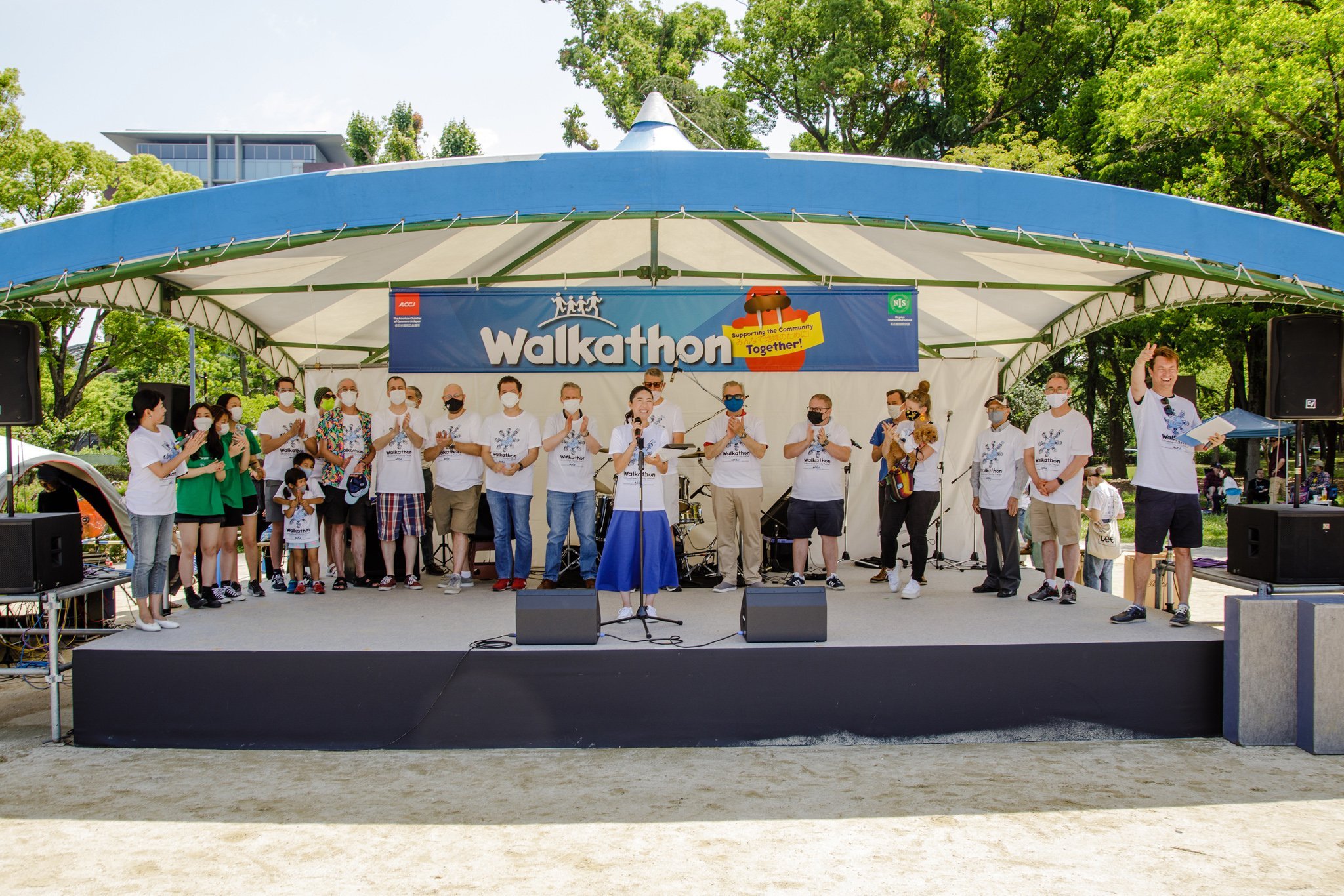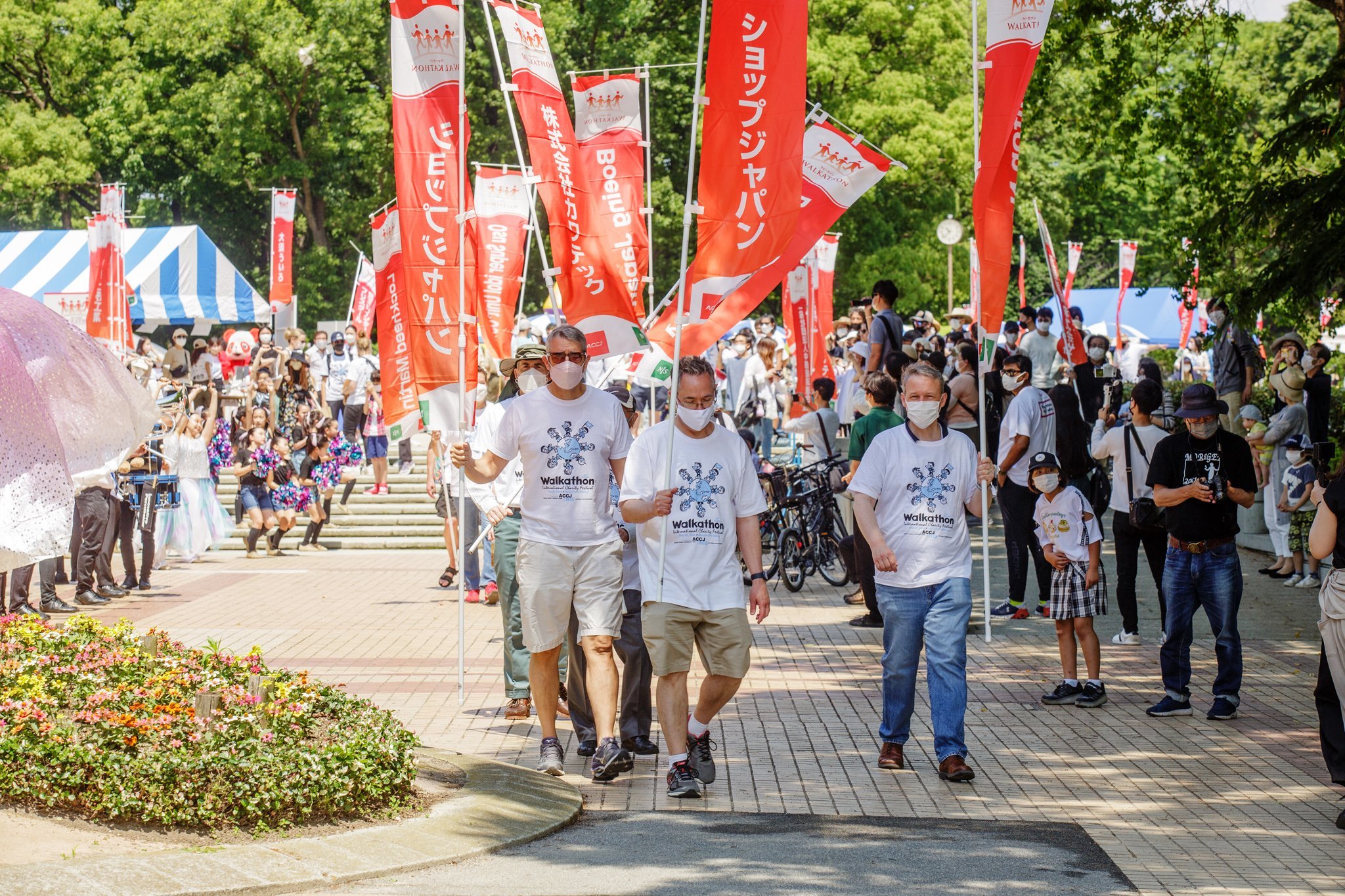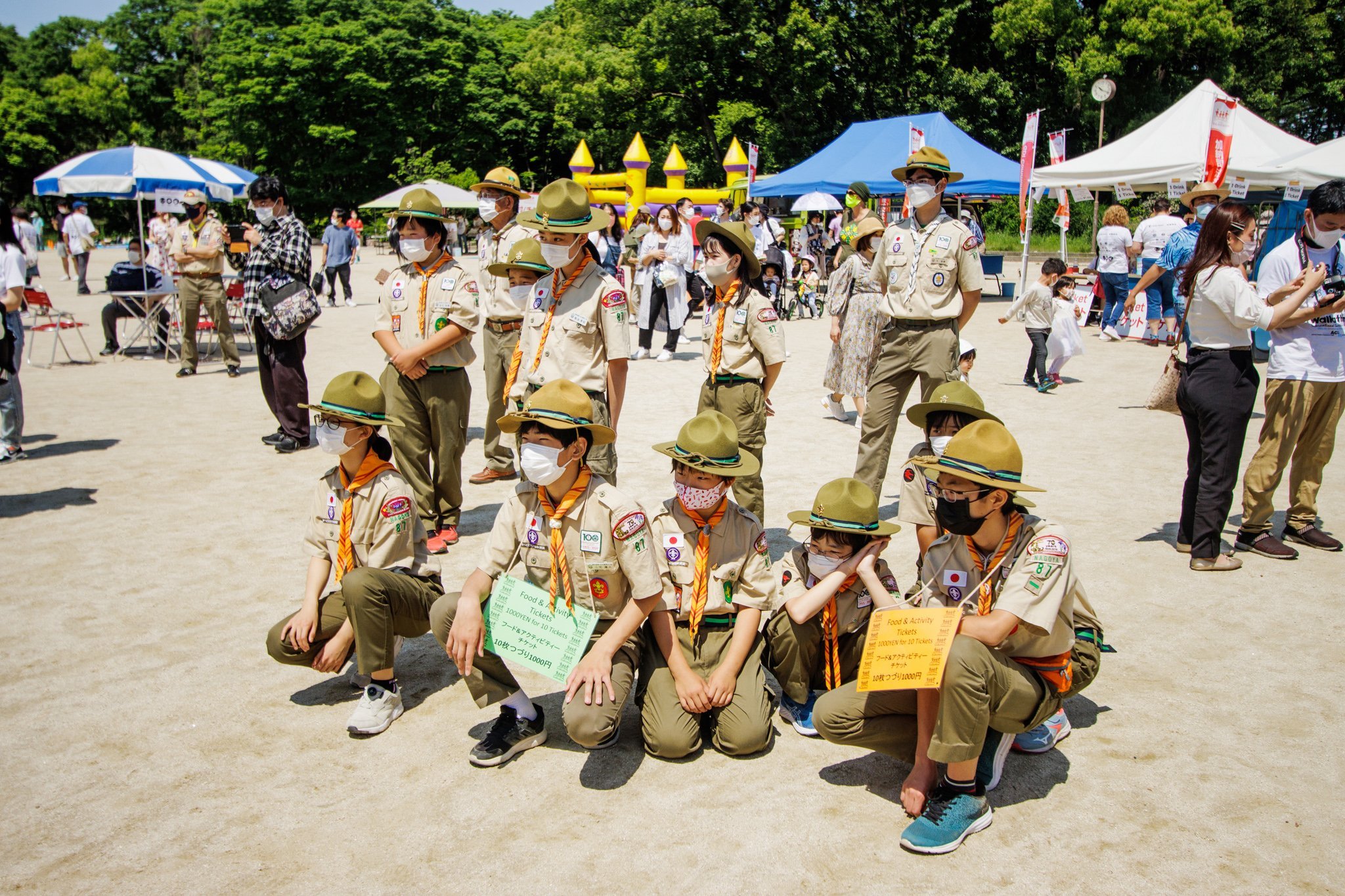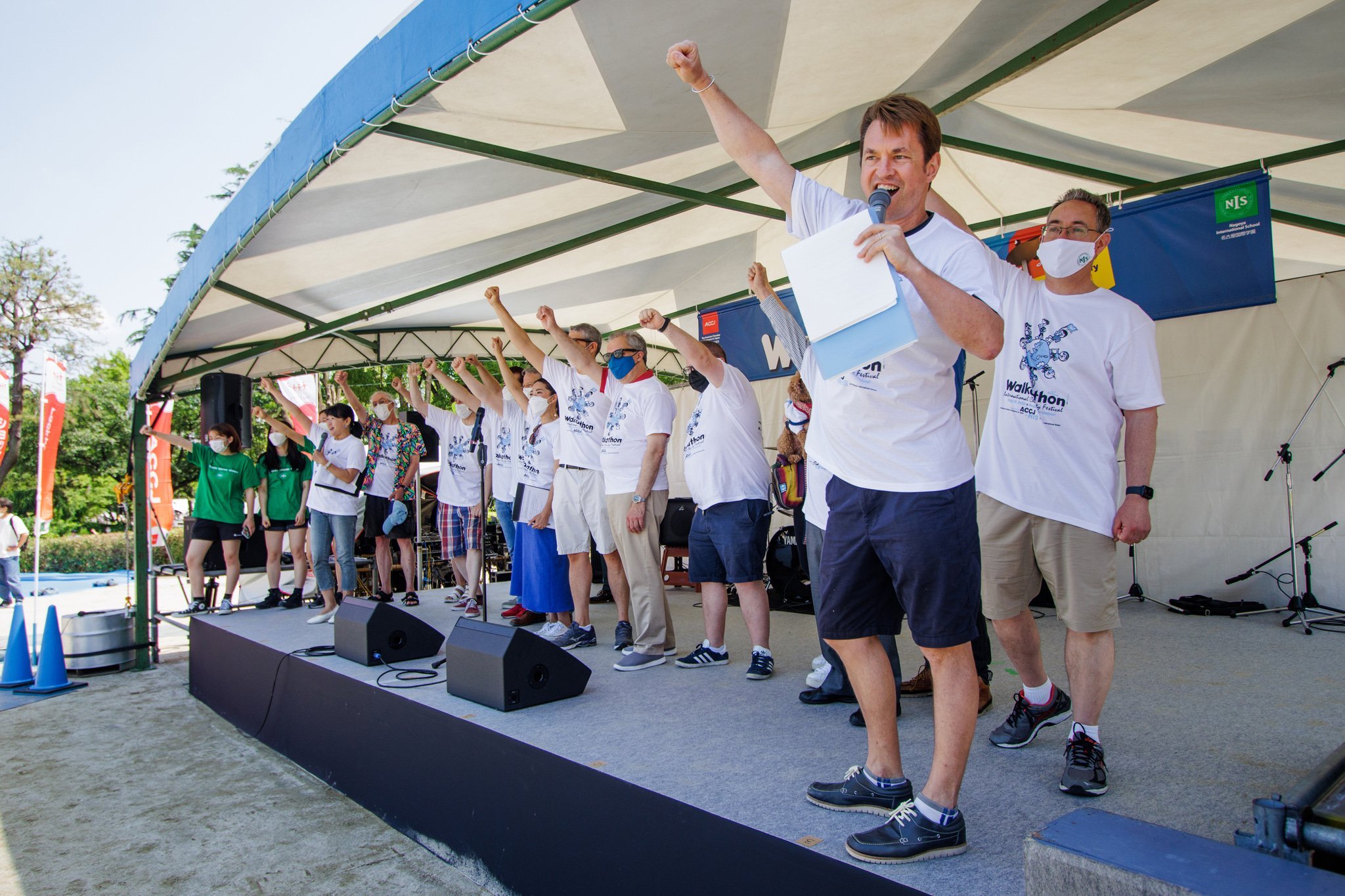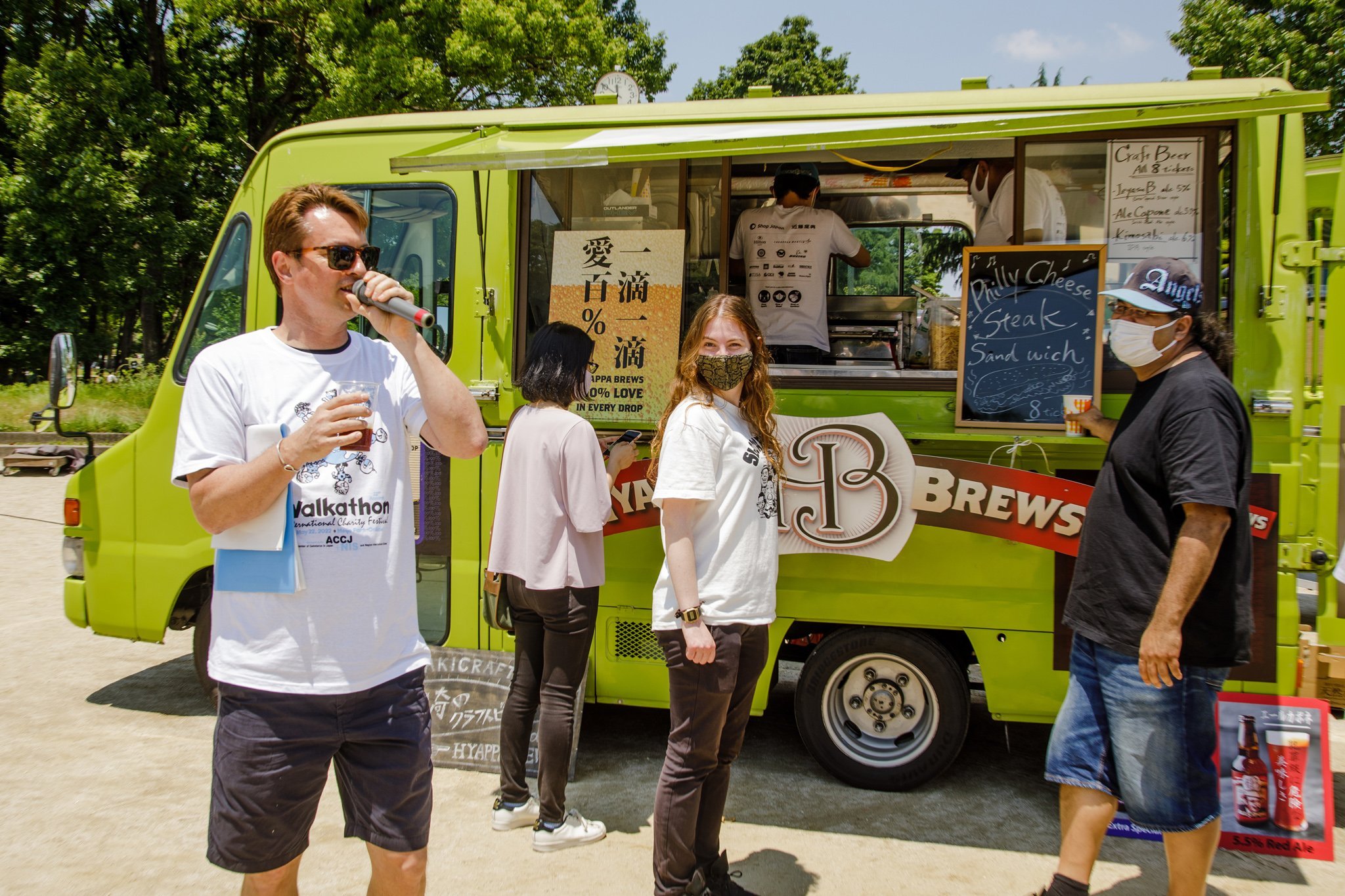Chubu Walkathon 2025
The ACCJ Chubu chapter hosted the 34th annual Walkathon on May 18 in Nagoya’s Meijo Park to support local charities and improve the lives of the less fortunate.
ACCJ members and guests gather in Nagoya’s Meijo Park to benefit local charities.
The American Chamber of Commerce in Japan (ACCJ) Chubu chapter hosted the 34th annual Walkathon on May 18 in Nagoya’s Meijo Park.
Held each year in collaboration with Nagoya International School, the mission of the Chubu Walkathon is to support local charities and improve the lives of the less fortunate by creating an opportunity to increase awareness, recruit volunteers, and raise funds at a family-friendly, international outdoor event.
“Your contributions help transform and support the lives of many individuals through the charitable organizations we assist, including individuals living with illness or disabilities, mothers and children affected by domestic violence, and children in need of educational support,” said Nao Geisler, chair of the 34th Chubu Walkathon Planning Committee and the ACCJ–Chubu Community Service Committee (pictured below, top center).
“This year’s event was a tremendous success, offering a meaningful opportunity for many attendees to create memories with their families and friends. We deeply appreciate your continued support and look forward to welcoming you again at next year’s 35th Anniversary Walkathon.”
Leading the Way
Meet the 2024 ACCJ Leaders and Volunteers of the years, recognized for extraordinary dedication to the chamber's mission.
The ACCJ recognizes exceptional contributions from across its three chapters
Each year, the American Chamber of Commerce in Japan (ACCJ) honors members who have shown extraordinary dedication. On December 5, six recipients were recognized for their work during 2024 by ACCJ President Victor Osumi at the chamber’s year-end Networking for the Future event at the Hilton Tokyo in Shinjuku.
Leaders of the Year
Tomoki Fukasawa
The ACCJ sincerely thanks Tomoki Fukasawa for his exemplary leadership of the Young Professionals Forum (YPF).
Since becoming co-chair in 2023, he has implemented a three-point plan for the YPF focused on consistency, engagement, and growth. The strategy was a great success in 2024, leading to seven sold-out events that attracted nearly 250 attendees.
Through his leadership and determination to support the next generation of leaders, Fukasawa has strengthened the chamber’s presence in the business community and created new opportunities for young professionals to get involved.
Nao Geisler (Chubu)
The ACCJ extends heartfelt thanks to Nao Geisler for her service as chair of the Chubu Community Service Committee.
Her leadership skills were critical to the success of May’s ACCJ/NIS Walkathon, which raises funds each year for local charities. While the event itself is just one day, its success is built on months of planning, logistics, and negotiations.
Geisler’s hard work this year led to a 15-percent increase in funds raised, enabling the ACCJ and co-organizer Nagoya International School to touch even more lives in the Chubu region.
Chihiro Kijima (Kansai)
The ACCJ recognizes Chihiro Kijima for her exceptional leadership as co-chair of the Kansai Diversity and Inclusion Committee.
As a key member of the Kansai Chapter, Kijima has guided the chamber’s D&I efforts at a critical time for the movement. Her leadership has ensured that members hear from dynamic speakers on topics that resonate with a diverse audience.
Kijima’s deep experience in event planning has extended the ACCJ’s influence in the Kansai region.
Volunteers of the Year
Mao Kawakami
The ACCJ expresses its sincerest appreciation to Mao Kawakami for her enthusiastic support of the Women in Business (WIB) Committee.
Kawakami’s excitement and dependability have brought fresh energy to the Breakfast in the Boardroom series.
By eagerly attending each briefing session with speakers, conducting impeccable research, and preparing spot-on invitations, she has been integral to the success of the series. Her passion for the WIB committee serves as an inspiration to others.
Natsuko Gomi (Chubu)
The ACCJ is indebted to Natsuko Gomi for her dedication to the Chubu Children’s Fund, which provides university and vocational-school scholarships to young adults transitioning out of orphanages.
Gomi’s commitment goes far beyond the typical volunteer role. Her ability to connect with students on a personal level has made a significant impact on their confidence and readiness to face the challenges of adulthood.
As she continues to streamline operations, Gomi’s passion for the fund has ensured that it can reach more students and provide the support they need.
Kishin Okada (Kansai)
The ACCJ expresses its deepest gratitude to Kishin Okada for his efforts to foster acceptance and energize young members as part of the Kansai Diversity and Inclusion Committee.
Okada has been instrumental to the success of the Kansai Chapter’s signature leadership series and the Kansai D&I Summit. And as a guest speaker for a Kansai Young Professionals event, he has also inspired the next generation of leaders.
An inclusive voice, Okada brings people together and forges new ideas while amplifying the ideas of young professionals.
Final Frontier
Cooperation between the United States and Japan in the space industry is growing stronger and represents a great pathway for innovation in the bilateral relationship. A significant player in the space travel industry in Japan is the Space Port Japan Association (SPJ), which was established in 2018 and is attracting considerable attention on both sides of the Pacific. SPJ co-founder and Representative Director Naoko Yamazaki joined members of the American Chamber of Commerce in Japan (ACCJ) on April 21 for an hour-long online discussion.
Former astronaut Naoko Yamazaki shares her vision for bilateral space cooperation and spaceports in Japan
Listen to this story:
The United States and Japan share a long history of collaboration in space, working together on projects such as the International Space Station (ISS) and the Artemis program, which aims to return astronauts to the moon by 2024 and can also be seen as a preparatory stage for human missions to Mars.
Cooperation between the two countries in the space industry is growing stronger and represents a great pathway for innovation in the bilateral relationship. A significant player in the space travel industry in Japan is the Space Port Japan Association (SPJ), which was established in 2018 and is attracting considerable attention on both sides of the Pacific.
SPJ co-founder and Representative Director Naoko Yamazaki joined members of the American Chamber of Commerce in Japan (ACCJ) on April 21 for an hour-long online discussion organized by the Chubu Aerospace and Manufacturing Committee.
Licensed to Fly
The accomplishments of Yamazaki, who participated as a panelist at the ACCJ Women in Business Summit in 2014, are impressive. Currently she is a member of the Committee on National Space Policy at Japanese Prime Minister Fumio Kishida’s Cabinet Office. And as a former astronaut with the Japan Aerospace Exploration Agency (JAXA), she became the second Japanese women to fly into space when she took part in an assembly and resupply mission to the ISS in 2010 aboard the space shuttle Discovery. She retired from JAXA in 2011.
Besides appearing in the media to promote the SPJ, Yamazaki occasionally meets with government officials in both the United States and Japan. For example, US Ambassador to Japan Rahm Emanuel greeted her and space startup leaders at the US Embassy, Tokyo, in February to discuss bilateral collaboration on the space front.
Direct Connections
During the April 21 webinar, ACCJ members learned that direct cooperation began with the signing of the 1969 US–Japan Space Agreement and has since blossomed into a relationship involving many US-made products. While a young organization, the SPJ has already established relationships with four regional governments interested in hosting spaceports. The projects include:
- HOSPO (Taiki, Hokkaido Prefecture)
- Spaceport Kii (Kushimoto, Wakayama Prefecture)
- Shimojishima Spaceport (Okinawa Prefecture)
- Spaceport Oita (Beppu, Oita Prefecture)
Other cities in Japan are also interested in such an investment in point-to-point suborbital space transportation hubs.
Besides sending future passengers to other planets, spaceports in Japan could become a launchpad from which to transport time-sensitive food and cargo to other locations on Earth. For example, Yamazaki pointed out, entrepreneur and investor Elon Musk proposed in 2017 a plan to use his SpaceX rockets to fly passengers from New York to Shanghai in just 39 minutes.
Supporting STEM
Yamazaki is recognized as a space policy expert not only in Japan but also in the United States. She was recently invited by the University of Pennsylvania (Penn) as a visiting fellow at the Perry World House, a center for scholarly inquiry, teaching, research, international exchange, policy engagement, and public outreach on pressing global issues. She is lending her expertise to Penn so that its students can develop and advance innovative policy proposals, and hopes to see more Japanese students benefit from the experience of studying abroad.
Finally, Yamazaki spoke about her involvement in the Japanese Rocket Society, where she chairs the Sorajo Committee, whose name means women in aerospace. She is a staunch advocate of inclusivity and gender equality in the Japanese aerospace industry—a goal very much aligned with the beliefs of the ACCJ and its member companies. Science, technology, engineering, and mathematics—or STEM—is a growing area of passion for this former astronaut, and we hope to see her and other members of the SPJ at future ACCJ events.
Chubu Walkathon
On May 22, more than 1,000 participants took part in the 31st Annual Chubu Walkathon International Charity Festival. This year’s event took place on a beautiful Sunday in Nagoya’s Meijo Park and was also livestreamed. More than ¥7 million was raised to support local charities.
Annual event raises millions of yen for charity on a sunny day of food, friends, fun, and fitness in Nagoya
Photos by Andy Boone
On May 22, more than 1,000 participants took part in the 31st Annual Chubu Walkathon International Charity Festival. This year’s event took place on a beautiful Sunday in Nagoya’s Meijo Park and was also livestreamed. More than ¥7 million was raised to support local charities. The Walkathon’s mission is to improve the lives of the less fortunate by creating an opportunity to increase awareness, recruit volunteers, and raise funds at a family-friendly, international outdoor event. More than ¥177 million has been donated over 31 years, and 18 charities received funds in 2021.
Entrepreneurship in Japan and Beyond
When entrepreneurs consider entering the Japanese market, often they eye the nation’s capital as their starting point. The allure of Greater Tokyo, with its population of more than 35 million, is strong. But ask American Chamber of Commerce in Japan (ACCJ) Vice President-Chubu Robert Roche where you should start and he’ll invite you west, to the city of Nagoya.
Oak Lawn Marketing co-founder Robert Roche shares his personal journey
When entrepreneurs consider entering the Japanese market, often they eye the nation’s capital as their starting point. The allure of Greater Tokyo, with its population of more than 35 million, is strong. But ask American Chamber of Commerce in Japan (ACCJ) Vice President-Chubu Robert Roche where you should start and he’ll invite you west, to the city of Nagoya.
It was there that the entrepreneur, investor, civic leader, and philanthropist got his start building businesses, and he believes that the capital of Aichi Prefecture, in the central Japan region of Chubu, remains one of the best places in the country for entrepreneurs.
He expanded on this while also sharing his personal business journey on September 3, during an event hosted by the ACCJ-Chubu Programs Committee. The virtual session was a one-on-one discussion between Roche and his longtime friend and ACCJ-Chubu External Affairs Committee Co-chair Michel Weenick. Together, in 1990, they helped found the American Business Community Nagoya (ABCN), a hub for the US and greater international business communities in Nagoya. The ABCN became the Chubu chapter of the ACCJ in 2000.
The Magic of Nagoya
Roche joined the session from China, where he currently invests and does business in addition to his US and Japanese endeavors. But he remains very involved in Nagoya. In 2018, he returned to Oak Lawn Marketing, Inc., the company he co-founded with Tadashi Nakamura almost 30 years ago, as executive chairman and president.
Although Oak Lawn Marketing, and its Shop Japan e-commerce brand, are well known today, their start is sure to inspire burgeoning entrepreneurs. Roche shared the story.
Recalling those early years after university, when he had recently married, he explained: “My wife’s family is from Nagoya, and they didn’t want me to be anywhere else. So, I had this constraint of needing to figure out something to do. I didn’t know what to do, but [whatever it was] I needed to do it in Nagoya.”
He soon met Harry Hill, a current ACCJ governor who has long been a leader in the Chubu community as well.
“Harry and I became partners pretty much the second day after we met, in 1990. He had his own business, and I had my ‘business’ that really wasn’t a business—it was just me kind of doing stuff,” he shared. “Then he and I formed H&R Consultants together, and that was really the beginning of a successful creation of a business. We are very complementary. He’s very good at stuff that I’m not very good at, and I’m very good at stuff that he’s less good at.”
Roche said that’s how he got started on the entrepreneurial front. At first, they made just enough money to survive. But after expanding H&R and earning a bit more, he got into the import–export business.
On Air
Initially, Roche was importing Tiffany products and L.L. Bean bags. His partner, Nakamura, being a local with lots of connections in Nagoya, was able to set up some meetings with a local TV shopping company.
“In the early 1990s, there was this show called Waku Waku Terebi Shoppingu. They would tape a one-hour program once a month and run it over and over on 25–30 stations. We were lucky enough to secure a four-minute spot for Tiffany,” Roche recalled.
Soon he found himself selling Tiffany items on television in Japanese—a stint that his mother-in-law enjoyed critiquing—and the seeds for Oak Lawn Marketing and Shop Japan were planted.
As a result of these appearances, Roche gained a reputation for having access to the country’s TV shopping market. One day, in 1992, he received a call from a company in Canada that was selling all sorts of products on CNN. Viewers around the world could call a local number in their country and order items such as the now-famous Didi Seven stain remover. But not in Japan.
The company saw Roche as their path into the market. They told him that he needed to have a call center, a fulfillment center, and all sort of other things.
“I didn’t have a call center. I didn’t have logistics ready. I didn’t have anything,” Roche recalled. “I said, ‘Sure we got it, we’re gonna go, you just let us know.’ And then they said that we had to make a minimum order. I asked how much, and we just scrambled to get the money together. And we ordered all this stuff.”
At the start, Roche and Nakamura just ran calls through their tiny 100-square-meter office. They stored products there as well. The calls started rolling in, and the business grew. Doing fulfillment from the office wasn’t easy. “One of the products was a stepper machine, and some days we’d send out 100. We were landlocked, trapped in the office until the Sagawa guy came and took the boxes away,” he remembered.
“If I was a better planner, I would have had all that stuff in place before the first call came. But we just had to adapt. And that was good, because we learned every key part of the business. The very beginning, that was fantastic.”
Accelerated Growth
The business grew incrementally until they were bringing in about ¥1.5 billion per year. At that point, something different was needed to take the next step.
“As entrepreneurs, we love chaos. We love to be the hero. We love for there to be a problem and then come in and solve that problem,” Roche said. “H&R Consultants kind of went through this. Harry and I ran it, and then we brought in John Coomes to run it, and then Scott Reid, and then Harry went back to the States and did a big development. When he came back in 2004, there really wasn’t a spot for either of us at H&R anymore.”
So, Hill joined Oak Lawn Marketing and this, Roche said, is when things really began to take off.
“The company didn’t need a firefighter anymore; it was getting pretty standard. We had a nice foundation, but what really moved it [to the next level] was that Harry just took over and he banged it out,” he explained. “I think that, from an entrepreneur’s perspective, there is always that time when, as a founder, you have to hand off.”
Fast-forward to 2017 and Hill handed back the baton. “But he gave me a much bigger platform than I gave him,” Roche said.
Making Connections
For the success they have had, Roche credits the environment of Nagoya and the easier access to top executives compared with Tokyo.
One of the things he said was most important to him about being a young entrepreneur in Nagoya was the access to people whom he never would have met in Tokyo.
“There were all these real leaders of Japanese industry who we had access to. We never did business with those guys ever, but we learned from their demeanor, and they told us little things like, ‘Don’t say it that way.’ You would say something [in Japanese] and they would kind of twist their head and you would think, ‘Oh, that’s not the way to say that,’” he recalled. “It was this almost subliminal teaching from true leaders [that helped], and we never would have gotten access to that caliber of leader in Tokyo. The big business guys of the ACCJ in Tokyo do, and now we do. But then? No way.”
To make the most of such opportunities, Roche advises entrepreneurs to learn Japanese.
“If you think you can do this without speaking Japanese, you can—you can be that unicorn—but I’ll tell you right now, it’s better to speak Japanese,” he said.
That’s because it’s the unplanned conversations you end up having with people whom you didn’t plan to meet that can make a difference and lead you down unexpected—and fruitful—paths.
“Learn Japanese if you’re going to do business in Japan, because there are all these seasoned guys like Nakamura, who could not have communicated with me in English. And I learned from that guy. That’s what really made a difference.”
More Advice
“Hire planners.” That was Roche’s tip when Weenick asked if he is a better planner today than he was 30 years ago, when he dove right into the pool of TV shopping. Often, entrepreneurs feel as if they can do it all. But to really succeed requires surrounding yourself with those who are more skilled in areas where you are weak, just as Hill and Roche complement each other in their business endeavors.
“My plan, basically, is to hire people to run the business who are better planners than me,” he said. “I hire people who can plan and not react—because I’ll react for them.”
Then Roche gave his biggest recommendation: Don’t take no for an answer. “I was told no every day, 10 times a day. You can’t do that. You can’t do that.” It’s one of the realities of Japan’s very orderly society—with its resistance to deviating from exactly what has been laid out—that can be discouraging to those wanting to explore new ideas.
But he encouraged people not to let the little things that sometimes frustrate expats get to them. “There is a tendency to get a little bit negative on Japan,” he noted. “We’ve all sat through those complaint sessions. Why do they do this? Why is it that way? Why are a bunch of things out of our control? But, really, it’s the positive nature of this that we should focus on. Japan is a very, very good market, because things don’t change much. And the reality is that most people in Japan want to see foreigners succeed.”
To sum it all up, Roche looked back at how, perhaps by lucky chance, he was accepted into the local business community, the mura (village), as he called it, and why it’s important to become part of the group.
“If you hang out in the village long enough, you understand the rules and you just get incrementally bigger and bigger and bigger. And then you can diversify. I do a lot of business in China, and I do a lot of business in the States, but Japan is a really, really nice base, if you can keep it going.”
Nagoya Means Business
Now more than ever, Nagoya means business. The Chubu region, and specifically the city of Nagoya, has attracted many large tech companies and manufacturers—from automotive to aerospace—because it offers a skilled and talented workforce, affordable land, and a competitive cost of living. With a dedicated focus on creating an innovation ecosystem, Japan’s fourth-largest city has become an attractive location for small business owners and entrepreneurs.
Reflecting on the region’s supportive business climate
Now more than ever, Nagoya means business. The Chubu region, and specifically the city of Nagoya, has attracted many large tech companies and manufacturers—from automotive to aerospace—because it offers a skilled and talented workforce, affordable land, and a competitive cost of living. With a dedicated focus on creating an innovation ecosystem, Japan’s fourth-largest city has become an attractive location for small business owners and entrepreneurs.
Nagoya has traditionally been a center for manufacturing and industry, but as home to an innovative tech scene it is also fertile ground for startups. As an expat and a serial entrepreneur, I launched several businesses in the early 1990s, of which two are well-known today: Oak Lawn Marketing, Inc. and H&R Consultants K.K.
Oak Lawn Marketing was incorporated in Nagoya in 1993. Now, more than 30 years later, that small startup is a direct-marketing giant with more than 1,000 brick-and-mortar Shop Japan stores selling some 3,500 products in locations across the country.
Over the past three decades, I’ve managed, invested in, or founded more than 50 companies around the world. I chose Nagoya as the location for Oak Lawn Marketing because it’s where I lived when I first came to Japan. As an undergraduate and law student in the United States, I participated in study abroad programs at Nanzan University, where I met my wife.
Starting a business in a foreign country—in my second language—was challenging to say the least. Today it is much easier, and there are so many solid business reasons to choose the supportive environment of Nagoya.
Big Market for Small Business
With so many people from abroad now doing business in Japan, the business community in Nagoya has become much more accustomed to working with non-Japanese. It is also very open to entrepreneurs. While Nagoya is one of Japan’s largest cities, it is somewhat off the beaten track. Yet, with 2.3 million residents, it offers a market that is large enough to develop critical mass. In addition, the cost of living is a fraction of what it is in Tokyo.
Government support for small businesses and entrepreneurship has increased incrementally over the past 20–30 years, and these enhancements all add up to creating a solid environment for foreign entrepreneurs to do business in Japan.
In addition, the government fosters entrepreneurial collaboration through communal spaces, education, and networking opportunities. These include the Nagoya Innovator’s Garage, created by the Central Japan Economic Federation and Nagoya City, as well as Nagoya Connéct, powered by Venture Café Tokyo.
Local universities also provide educational and networking opportunities, while organizations—such as the American Chamber of Commerce in Japan’s Chubu chapter—offer outstanding opportunities for networking and mentorship.
Startup Ecosystem
Recently, I participated in a government task force on startups which brought local business leaders together to enhance regional entrepreneurship and innovation by combining different fields and creating new industries. The goal is for central Japan to expand beyond manufacturing into other industries.
I learned that, in 2019, startups in Aichi Prefecture raised the third-largest amount of funds in Japan. The abundance of ideas, technologies, and support services necessary for startups to grow is providing a tailwind for new businesses. Large companies based in Nagoya are instrumental in supporting the startup ecosystem, and smart human resources are further driving the local economy and actively engaging in innovation activities.
In 2020, Aichi–Nagoya was named a “startup ecosystem global hub city” by the Cabinet Office. This ecosystem aims to realize growth that drives the Japanese economy, and the creation of startups and new industries continues to promote innovation in this central region of Japan.
Government and local business leaders, as well as universities, are working together to form a globally cohesive innovation and startup ecosystem by utilizing the deep tech and manufacturing knowledge that is the strength of the region.
As a lifelong entrepreneur, I’m excited about the opportunities offered to a new generation of dreamers and doers. There has never been a better time to start a business, nor a better place to do it than Nagoya!
Nagoya Resources for Entrepreneurs
Startup Guide Nagoya
Developed by the Nagoya Innovator’s Garage and Nagoya City, this guide—available in digital and print formats—shares practical information about startups, coworking spaces, business programs, schools, and investors.
Nagoya Innovator’s Garage
Created by the Central Japan Economic Federation and Nagoya City, this coworking space furthers entrepreneurial collaboration through social nights, innovation events, and more.
Nagono Campus
Located in Nagoya City, this renovated elementary school offers three types of offices and serves as an incubation space in which to encounter and blend with people to create new values and form new businesses.
Nagoya Connéct
Powered by Venture Café Tokyo, this innovation promotion and exchange program holds a free event on the fourth Friday of each month that includes panel sessions, workshops, and networking opportunities.
National Innovation Complex
Part of Nagoya University, the National Innovation Complex is home to the Promotion Office for Open Innovation, which aims to establish a structure that enables companies and university researchers to promote and manage large-scale joint research projects.
The Tongali Project
Offered by five universities in the Tokai region, this multifaceted program supports the next generation of entrepreneurs.
Digital Transformation of Committees
When the ACCJ kicked off the transformation of its website platform early last year, the process sparked a conversation among members of the Chubu chapter about what digital tools our committee leaders need to succeed in bringing value to members and addressing pain points.
Removing barriers and ensuring continuity through centralized tech
Listen to this story:
When the American Chamber of Commerce in Japan (ACCJ) kicked off the transformation of its website platform early last year, the process sparked a conversation among members of the Chubu chapter about what digital tools our committee leaders need to succeed in bringing value to members and addressing pain points.
Following ACCJ President Jenifer Rogers’s directive to improve succession planning, the Chubu chapter reviewed the impediments that committees were facing. The takeaway was that the committee chair usually has all the documents, templates, and contact lists on their computer, and no one else has access.
As Chubu Programs Committee Chair Ray Proper explained, “I have years’ worth of information about my committee activities on my own shared drive—for my current and past committees—that I think would be much more useful were it accessible to others as part of a formal arrangement.”
Sudden Shift
Often in the past, without warning a committee member may have had to move out of Japan for work. This made it difficult for the remaining members to continue with the committee’s activities. Similarly, if the chair had a sudden medical event or accident, the committee would tread water until they could get back on track. This meant that the bus factor—the minimum number of people who can be hit by a bus before a project comes to a stop—effectively has been one.
Lastly, for committee leaders, an ongoing issue has been new member retention. Sometimes, a person joins a committee, attends a meeting, then never attends another. The feedback we have received from such members to date is that it’s hard to get up to speed, because they don’t know what has been discussed in previous meetings, are unsure how they can contribute, and don’t know what tasks need to be carried out.
Centralizing
To address these issues, the Chubu chapter began piloting the use of cloud storage for the Chubu Walkathon. This was then rolled out to the other committees.
Chubu Community Service Committee Chair Erin Sakakibara shared how the move made a difference this year: “Thanks to cloud storage, we were able to organize all our content and collaborate. It was particularly valuable in providing a base and continuity to build on in subsequent years of the Walkathon,” she said.
“But to be honest,” she added, “though technology is the tool, it also takes human management. You need someone who is organizing files and providing guidance for the team to get the full benefit of the technology. We couldn’t have pulled off the Walkathon without the cloud capability or our captain, who kept us organized and honest in our tasks.”
Having a cloud drive reduced the amount of management required on the part of the chair, as individual members could update and share documents on which they were working. This also eliminated the question of whether a document was the latest version—a crucial timesaver for an event with 220 files, scattered among more than 45 folders, being worked on by 20 people over the course of six months.
Onboarding
Getting new committee members up to speed becomes easier when you can point them to a cloud drive and they can review all the materials and meeting minutes. This helps them quickly get an idea of the committee’s activities, as well as how the group is organized and managed.
The Chubu chapter has also created LINE groups for each committee, allowing speedier communication while also making things more accessible to new members, increasing engagement by adding more touch points.
For successor planning, cloud storage moves the breadth of knowledge from the chair into a repository that all can reference. This can remove the barrier to entry for members and allow current chairs to step down with minimum disruption.
The Chubu chapter will continue to look into other technologies to address issues as well as assist leaders and members, so that the chamber can provide more value to everyone involved.














